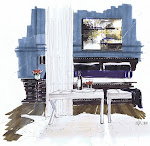 *Due to the horrendous formatting issues with blogger, and my long list of books, I will be doing two more entries :)
*Due to the horrendous formatting issues with blogger, and my long list of books, I will be doing two more entries :)
I have been reading Mary V. Knackstedt's book "The Challenge of Interior Design", and really enjoying it. Since she has been in business for over 30 years, you would think she is not very forward thinking, but to the contrary! She looks to the future of the industry, and what that means to us as growing firms.
This got me thinking about all of the great books we used in school, like my favorite, "Shaping Interior Space" by Roberto J. Rengel, or any or Francis Ching's books.
Here are some of my favorite reference books:
 Shaping Interior Space- Roberto J Rengel
Shaping Interior Space- Roberto J RengelIf you only read the first chapter of this book, you would get allot out of it. The reviews at the end of every chapter bring all the information together well, and if I had an hour or so, I would read just those.
A quote from LeCorbusier's "Towards a New Architecture" (Dover Publications: New York, 1968) from that first chapter reads:
"You employ stone, wood and concrete, and with those materials you build houses and palaces. That is construction. Ingenuity is at work...
But suppose that walls rise towards heaven in such a way that I am moved. I perceive your intentions. Your mood has been gentle, brutal, charming , or noble. The stones you have erected tell me so. You fix me to the place and my eyes regard it. They behold something that expresses a thought. A thought that reveals itself without word or sound, but solely by means of shapes which stand in a certain relationship to one another. These shapes are such that they are clearly revealed in the light. The relationships between them have not necessarily any reference to what is practical or descriptive. They are a mathematical creation of your mind. They are the language of Architecture. By the use of raw materials and starting from conditions more or less utilitarian, you have established certain relationships which have aroused my emotions"
This is what has always intrigued me about interior design...that you are capable of creating and manipulating feelings with interior space. I am an advocate of nature inspired interiors, and our relationship to the outdoors; that's no secret, and often look to the feeling of walking through the rainforest, the scale of the bog trees or the colour of bark to bring inside.
The power of design comes in creating spaces that are nurturing, in the case of court houses, or hospitals, where you feel safe and secure. In creating a space of gradure and worship that stretches to the sky, and includes an element of natural light that casts the perfect shadow; one that makes you raise your hands up. To create a getaway space that cocoons you in such a way, you can't explain it, but you need to return every year. This is the power of design.
 This page on free standing, and attached masses is definitely interesting!
This page on free standing, and attached masses is definitely interesting!
 The Interior Design Business Handbook - Mary V. Knackstedt
The Interior Design Business Handbook - Mary V. Knackstedt
An great book of business forms, and great info on managing an ID firm. How to make a profit, keep on top of changes in the industry and of daily operations. Many designers I know dislike the business element of design, but it makes more sense with a book like this.
I have used it many times, and my first contract was moulded from the one in the middle of the book. I saw Mary last week at the Seattle Design Center; you can read about it here.

This page of the book talks about fee structure; cost plus, percentage, hourly fees, and hybrids.

Home- Witold Rybezynski
The sub-title of this book pretty much says it all..."A Short History of an Idea". Ralph Lauren and his marketing genius is examined, as is what we think comfort is...not just physical comfort, but safety as comfort. He looks over the centuries to what has made us react in the way that we have to furniture, and interior spaces.
A great little book, and an perfect size read for a trip.

Designing Interiors- Rosemary Kilmer W. Otie Kilmer
Concept, FF & E, adjacency matrix, programming, bubbling, lighting, materials, history of design or technical drawing...this is the source! I have more post-its in this book than any other. This book takes you through the design process (or the domains) from programming through ideation and occupancy.

Page 164-165 features bubble and conceptual diagrams, ideation and schematics (my favorite part of design).
 Colour Drawing- Micheal E. Doyle
Colour Drawing- Micheal E. Doyle
Like I have said before, drawing and rendering can be learned! There are artists, and then there are those who read books like this, practice the techniques, no matter how much they suck, and learn to do it better next time.
Information and diagrams on shadows, blending, night scenes, materials, mediums, and indispensable techniques make this book one of my favorites. I learned later in school to use Sketch-up for perspectives, but typically use hand rendering on top of those dwgs for character.
Don't say you can't draw, until you read this book!

Notice the background of the shelves is shaded first, colour is added, details are brushed in, leaving white space around the rendering, and adding "glints and gleams" for lighting.
Part 2 of ID texts is coming soon!






 This page on free standing, and attached masses is
This page on free standing, and attached masses is  The Interior Design Business Handbook - Mary V.
The Interior Design Business Handbook - Mary V. 



 Colour Drawing- Micheal E. Doyle
Colour Drawing- Micheal E. Doyle



